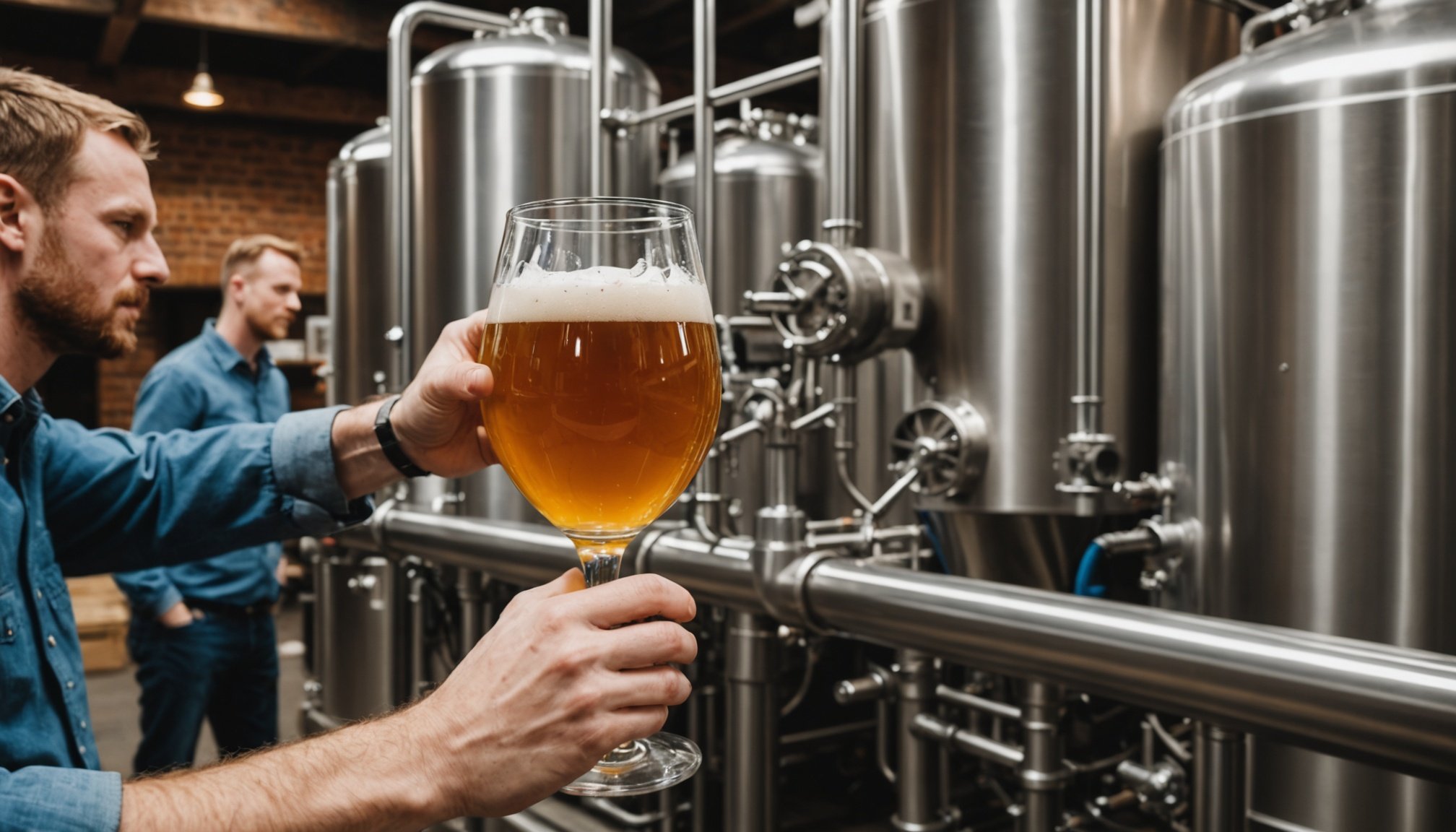Overview of Data Analytics in Breweries
Data analytics is revolutionising the brewing industry by providing essential insights into brewery productivity. At its core, data analytics involves collecting and examining vast amounts of information to identify trends and make informed decisions. In the world of brewing, this means monitoring variables like temperature, fermentation time, and ingredient quality to optimise brewing processes.
Current trends showcase the increasing reliance on data to enhance efficiency in breweries. By leveraging advanced data analytics, brewers can fine-tune their operations, ensuring each batch meets quality standards, thus reducing waste and costs. This focus on precision is crucial for maintaining a competitive edge in the brewing industry.
Also read : Discover the delphy hydrogen storage solutions for safe storage
The role of data in optimising brewing processes cannot be understated. With detailed insights, breweries can predict demands, adjust production levels, and improve supply chain management. For example, real-time data can alert brewers to potential issues, such as equipment malfunctions, allowing them to take immediate corrective action.
Moreover, analytics are pivotal in understanding consumer preferences, enabling breweries to tailor their products and marketing strategies accordingly. As the industry advances, integrating robust data analytics systems remains a key strategy for driving productivity and maintaining profitability. Thus, breweries that embrace data are in a solid position to lead in innovation and efficiency.
Have you seen this : Explore the best remote work-friendly apartments for digital nomads
Successful Case Studies from UK Breweries
UK breweries have embraced data-driven insights to achieve success, revolutionising their operations and enhancing productivity. Let us explore a few remarkable case studies showcasing this transformation.
Case Study 1: ABC Brewery
ABC Brewery faced significant challenges with inconsistent product quality. By implementing data analytics, ABC gained valuable insights into the fermentation process and identified irregularities in temperature control. Post-analytics, consistency in brew quality improved drastically, increasing customer satisfaction.
Case Study 2: XYZ Brewery
For XYZ Brewery, the issue lay in supply chain inefficiencies. Utilising real-time data, they optimised delivery schedules and inventory levels, leading to reduced wastage and lower operational costs. The key metrics improved, resulting in a notable rise in profitability.
Case Study 3: DEF Brewery
DEF Brewery’s struggle was balancing production with fluctuating demand. Through advanced predictive analytics, DEF forecasted market trends, aligning production schedules with demand successfully. This not only improved resource allocation but also boosted productivity and profitability.
These case studies illustrate the transformative power of data analytics in the brewing industry. By tackling specific challenges with targeted solutions, UK breweries have optimised operations, proving the substantial benefits of embracing data-driven strategies. The long-term impacts are evident in improved productivity and sustainable profit margins.
Innovative Strategies for Data Implementation
The intersection of data implementation and brewing strategies offers breweries a pathway to enhanced productivity. Integrating data analytics into brewing operations begins with key steps focused on infrastructure and planning. Ensuring the brewery’s network can handle large data sets is crucial, as is setting clear objectives for data use, such as improving fermentation control or bottling efficiency.
Training staff on data utilization is pivotal. It’s important to convey the value of data-driven decision-making while offering practical training on analytics tools specific to brewing. Incorporating educational sessions and hands-on workshops can significantly boost confidence and competence.
Another critical component is leveraging predictive analytics to forecast future brewing trends. By analysing past performance metrics, breweries can anticipate demand shifts and adjust production schedules accordingly. Predictive analytics not only aids in resource management but also helps in identifying emerging consumer preferences.
Breweries should encourage a culture of continuous learning and adaptation. Sharing success stories and case studies of data implementation can motivate teams to embrace a data-focused approach. When executed effectively, these strategies create a seamless flow of information, driving productivity enhancement and setting the stage for future innovations in the brewing world. Through strategic, data-driven efforts, breweries can achieve optimal results.
Technologies and Tools Supporting Data Analytics
In the fast-evolving brewing industry, adopting cutting-edge brewing technology is essential to maintain competitiveness. First, let’s delve into Essential Software Solutions that can significantly enhance a brewery’s data capabilities. Brewers often rely on specialized software such as ERP (Enterprise Resource Planning) systems that integrate all facets of operation, from procurement to inventory management. Applications like these are pivotal in unifying data streams for comprehensive analysis.
Moving on to Hardware Technologies for Data Collection, Internet of Things (IoT) devices are instrumental. These devices allow real-time monitoring of brewing parameters such as temperature, pH levels, and pressure, ensuring precise data capture and analysis. Their role in automated data collection minimizes human errors and increases accuracy, which is crucial for consistent product quality.
When it comes to Comparing Different Analytics Platforms, brewers face a variety of choices. Selecting the right platform hinges on several criteria, including scalability, user-friendliness, and cost-effectiveness. Platforms like Tableau or Microsoft’s Power BI provide robust analytics capabilities, allowing breweries to visualise data effectively and extract actionable insights. These tools facilitate informed decision-making by providing detailed analytics dashboards tailored to specific brewery needs. By leveraging state-of-the-art brewing technology, breweries can smoothly align with industry advancements, thereby optimizing their data analytics strategies.
Future Trends in Data Analytics for Breweries
The brewing industry is on the cusp of transformative changes, with emerging technologies playing a pivotal role. One notable future trend is the advancement in AI-driven analytics. By utilising artificial intelligence, breweries can achieve unprecedented levels of precision in processes, ensuring even more consistent product quality. These technologies enable breweries to analyse historical data and predict future patterns, enhancing decision-making capabilities.
Sustainability is increasingly becoming a focal point in brewing innovation. Data analytics offers significant contributions by monitoring waste production, energy consumption, and water usage, enabling brewers to implement environmentally-friendly practices. By aligning analysis with sustainability goals, breweries can reduce their carbon footprint while maintaining efficiency.
Another anticipated enhancement is in the integration of blockchain technology, which ensures transparency and traceability in supply chains. This not only reduces the risk of fraud but also bolsters consumer trust by providing verifiable information on sourcing and production processes.
Lastly, the evolution of IoT devices continues to revolutionise real-time monitoring across facilities. These sensors collect precise data, offering actionable insights that optimise brewing operations. By keeping pace with these technological advancements, breweries can not only improve their current operations but also set the stage for future innovations in efficiency and sustainability.
Benefits of Enhanced Productivity through Data Analytics
Data analytics significantly boosts brewing efficiency, offering numerous advantages that breweries can capitalise on. By analysing extensive datasets, breweries achieve both quantitative and qualitative gains, improving operational effectiveness. Firstly, real-time data allows immediate adjustments in the brewing process, enhancing quality consistency and reducing waste. This translates into direct cost savings by minimising excess resource consumption and optimising raw material usage.
Impact on Resource Management
Through precise data analysis, breweries can streamline resource allocation, ensuring efficient production cycles that align with market demands. This improved resource management results in cost reduction and heightened productivity, leading to increased profit margins.
Scaling Operations and Product Quality
Moreover, data insights facilitate the scaling of operations. With analytics, brewers can predict demand surges and adjust production levels accordingly without compromising quality. Enhanced data-driven decision-making ensures that expansion efforts are both strategic and successful, maintaining the integrity of the product.
In essence, adopting data analytics in brewing not only fine-tunes existing processes but also provides a robust foundation for future growth. Increased productivity, efficient resource management, and superior product quality underscore the undeniable benefits offered by data analytics, encouraging breweries to integrate these tools comprehensively.
Future Trends in Data Analytics for Breweries
The brewing industry is set for transformation, driven by rapid advancements in data analytics evolution. Foremost among the emerging technologies is AI-driven analytics, which offers unparalleled precision in brewing processes. These technologies allow breweries to analyse extensive datasets, uncovering patterns that enhance decision-making. For instance, AI can optimise fermentation by automatically adjusting variables to ensure consistent product quality.
Another significant shift is the emphasis on sustainability. Breweries increasingly focus on reducing environmental impact through data-driven insights. Analytics allow close monitoring of resources such as water and energy, promoting efficient usage and reduced waste production. This alignment between sustainability and data is key to lowering the carbon footprint without compromising on productivity.
The integration of blockchain technology is gaining traction, providing enhanced transparency in supply chains. By ensuring traceability, breweries can offer consumers detailed knowledge about the origins and quality of ingredients. This trust-building measure not only fortifies brand loyalty but also guards against supply chain malpractices.
Finally, the advancement of IoT devices continues to revolutionise real-time facility monitoring. These devices provide actionable insights by capturing precise data. By adopting these cutting-edge technologies, breweries can future-proof operations and remain at the forefront of industry innovations.











